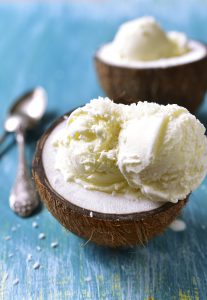I Scream, You Scream, We All Scream for iTiceCream!
There’s almost nothing better than a big scoop of ice cream on a hot summer day. The creamy satisfying texture and mouthfeel is hard to beat. Most ice cream shops only offer dairy-based ice cream and dairy-free alternatives have only just begun to pop up in pints in the freezer section of grocery stores.
People’s dietary needs are changing. Accommodating consumers’ trending new diets is easier than you may think. iTi Tropicals suggests using a coconut base in place of traditional dairy milk. It has health benefits, it is cholesterol free and it contains MCT’s — medium chain fatty acids — which are easily digestible and converted to energy. How’s that for having your dessert and eating it too?
Here are 3 tips and a base recipe to make dairy-free desserts so close to cow’s milk, your customers will never miss the dairy. Let the brain freeze begin!
First, create your base.
If you desire a final product that is ultra-creamy, silky smooth and decadent, then a higher fat content, such as coconut cream, is the best bet. Since fat has a different rate of freezing than water, your finished product will be smoother and less ‘icy.’
iTi offers two coconut creams, 24% and 30% fat that will provide your dessert a silky smooth texture. The higher fat content allows flexibility to create a finished product that suits the desired nutritional profile by diluting the cream with water, coconut water or even fruit juice.
Second, select your sweetener.
Your sweetener options will be selected based on your label and desired target consumer. A granulated sweetener like cane sugar or coconut sugar is a good choice. Alternatively, you can opt for liquid sweetener like honey, maple syrup, or agave.
If the sweetener is granulated, you will have to dissolve the sugar in the base before churning it, which means you’ll also have to chill the base for longer before being able to make your finished product.
Lastly, stabilize!

When using eggs in ice cream, you’re making a custard base which then gets churned and frozen. Custards tend to be creamy with a very smooth thick texture.
Egg yolks are composed of fat and protein, and help keep the ice c
ream smooth. The lecithin in yolks, acts as an emulsifier: the proteins in the yolk bind with water and fat molecules in the milk, which results in a more stable a
nd creamy end product.
The dairy-free consumer is often avoiding eggs. By using a natural thickener such as xanthan gum, you can create the same mouth-feel and experience you get with dairy ice cream with just coconut milk. The coconut milk does double the work in non-dairy frozen desserts, providing both the body and the stability.
Dairy Free Frozen Dessert Bas
13.5oz Coconut Milk, Full Fat
2200 iTi tropicals Coconut Cream 24% + Water
8 oz. almond milk or cashew milk
150g liquid sweetener such as honey or tapioca syrup
2.5g xanthan gum
0.5g kosher salt
Tags: Applications coconut cream dairy-free dessert Ice Cream
